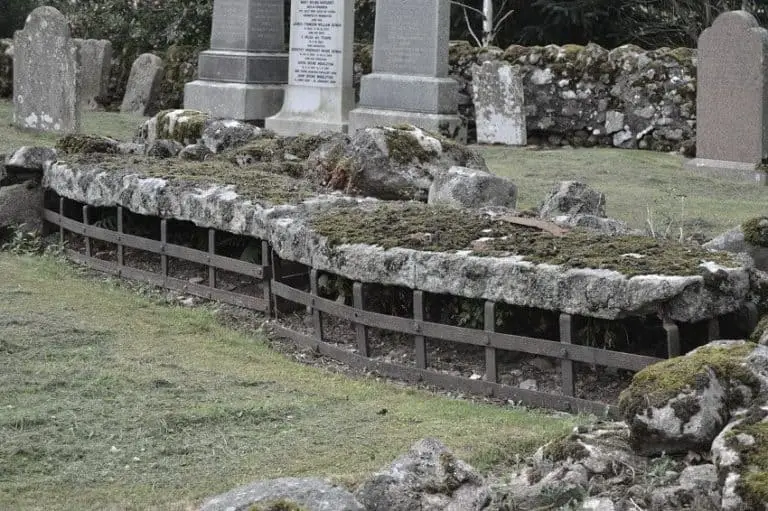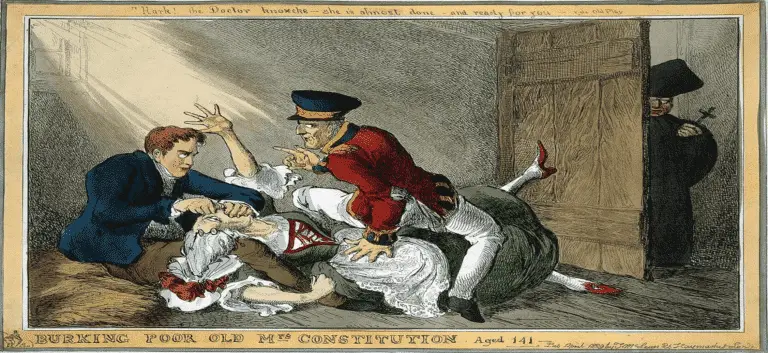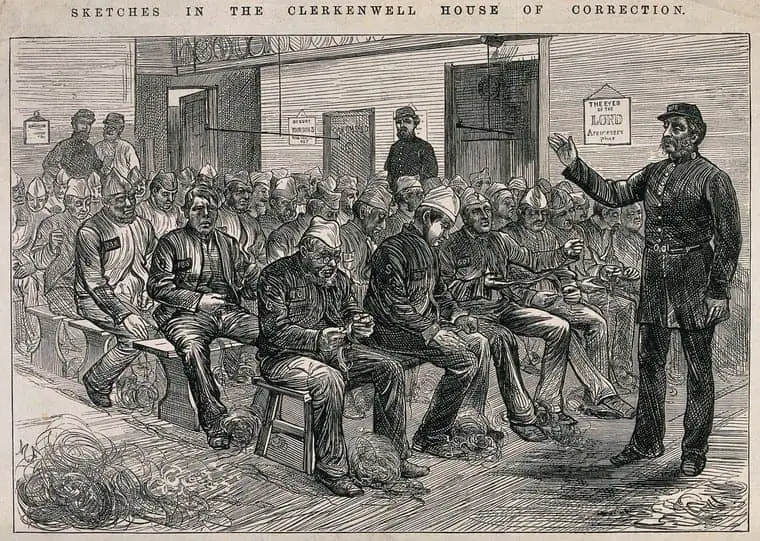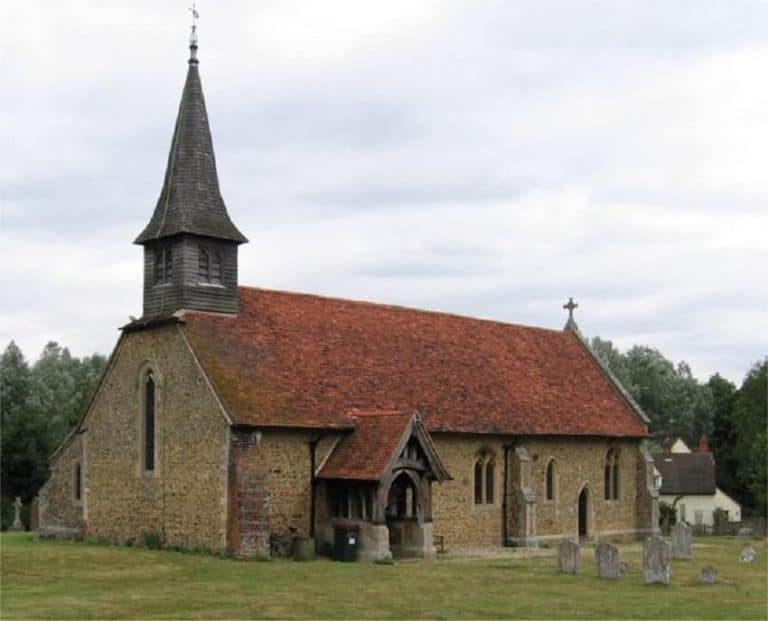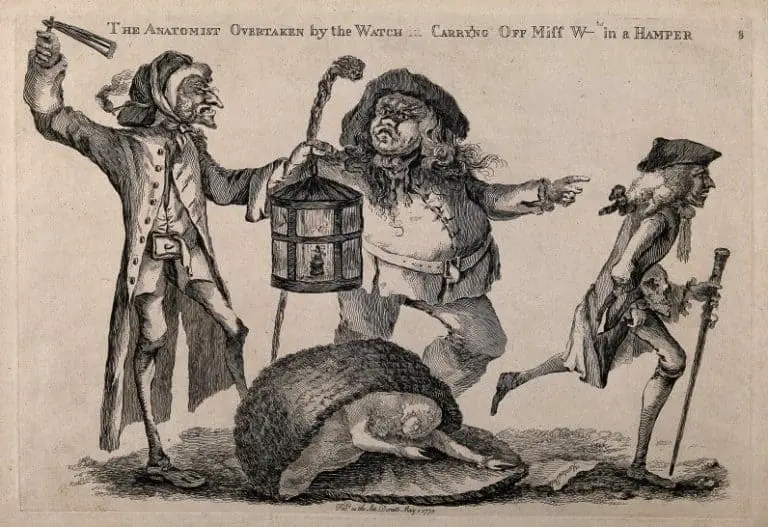Fundamental Rules of Georgian Body Snatching
Being a body snatcher came with a few fundamental rules. It wasn’t just about digging up a cadaver and getting it safely back to the anatomy school or squashed into a hamper for shipping.
Body snatching was much more than this. Fail to follow these basics, and chances were you’d be spending a fair bit of your time in goal.
There were some basic rules that most, if not all, body snatchers would have followed. The simplest of these was to use a wooden shovel so as not to attract attention to the noise when digging and don’t snatch under a full moon. The removal of the cadavers teeth before the corpse was handed over for sale was a must, as was removing any burial clothes and throwing these back into the bottom of the coffin. And never dig up the whole coffin.

Each resurrectionist would also have had their own personal rules in which they followed. Perhaps to follow a ritual, carrying out something particular to them that they’d developed during their years of successful grave robbing.
But let’s take a look at the essential rules that any body snatcher who knew what they were doing, would almost certainly have followed.
Always Use A Wooden Shovel
Perhaps the main characteristic of being a body snatcher, apart from having a strong stomach, was stealth.
It was no use creeping into a graveyard undetected only to draw attention to yourself as you were frantically digging away at a grave.
To combat this, body snatchers used wooden shovels; the noise generated when hitting stone was far less than if a metal shovel was used.
This was particularly helpful if the targeted plot had had stones or straw incorporated into the soil as the grave was being refilled; a practice commonly favoured among the poorer members of the parish.
I’ve written a post on body snatching prevention methods of the poor which you can read here, but in essence, those who could not afford things like mortsafes, incorporated stones or staw into the soil in the belief that it would slow down the digging process, making the grave less attractive to resurrectionists.
Never Work Under A Full Moon

The moon played a critical role in a body snatcher’s work. It would have lit up the graveyard just enough to have aided detection if the parish watch were out.
Evidence of the moon playing a key role in the act of body snatching can be found in the Resurrectionists ‘Diary’ where the writer, who is believed to have been Joseph Naples, pencilled in “Rules for finding the moon on any given day’ on the back pages, thus allowing the gang to see when their optimum snatching days would be.
On the night of Tuesday 25 February 1812, an entry in the Diary tells us that ‘the moon [was] at the full, could not go [out]’.
This would have been a hindrance to the gang as they had already been forced to stay at home the previous evening due to other gang members getting a little too drunk to have been of any use with a spade.
The night of Thursday 27 August 1812, was also regarded as being ‘too light’ for the gang, as they didn’t go out on this night either.
August is rather an odd month to be body snatching, for the dissecting season was yet to start. The ‘season’, running from October to May, was set mainly because the colder weather allowed for the slower decomposition of the cadaver, meaning more dissecting time and less of a pungent odour.
The bodies snatched during August may be supplying private or extra-mural anatomy lectures and the Diary records that the cadavers were sold to various anatomists and hospitals including St Thomas’ and Bartholomew’s.
Never Take The Burial Clothes
This is perhaps the most important of all body snatching rules. Fail to follow this one, and you could expect to be punished accordingly. Your crime would quickly escalate from a misdemeanour to a felony.
I’ve written a post highlighting the main punishments that body snatchers received if they were caught and you can read it here, but, by stripping the cadaver of all its ‘property’, that is a burial shroud, jewellery if any, plus anything that was removable, you could then only be accused of stealing a dead body.
And a dead body didn’t belong to anyone.
Reports of churchyards being targeted by resurrection men often recount that the grave clothes were found after having been thrown back into the foot of the coffin, or that they were found strewn across the graveyard itself.
Perhaps the most notorious body snatcher for failing to leave the burial clothes at the scene was Thomas Goslin alias Vaughan, a one-time member of the Borough Gang. Due to his prolific snatching attempts, Goslin found it wise to leave London and eventually found his way to Stoke Damerel, near Devonport.
By the time he reached here, he’d been in the body snatching trade for over thirteen years and should have known better. He was caught red-handed with grave clothes in his home which included stockings and a shift.
Goslin, together with three other associates, one of them his wife Louisa, were transported to Van Diemen’s Land for seven years.
Always Remove The Teeth

Our Georgian ancestors had a penchant for false teeth. And human ones at that. Their love of sugar was rapidly resulting in many of the upper members of society having blackened, toothy grins and their solution for this was to wear false teeth.
False teeth had traditionally been made from either ivory or bone, and for a brief time, these replacements would have sufficed. But, unfortunately for many, these replacements started to fade after a while.
It was found that the ivory and bone would easily stain and decay due to the lack of enamel, sending many people back to square one.
Human teeth however didn’t. In fact, human teeth, it was found, gave a very natural appearance and certainly wouldn’t have stained as easily their calcium counterparts. And this meant big business.
With clients willing to pay, dentists were all the more eager to get their hands on human teeth and the resurrectionists were only too happy to oblige.
Extracting the teeth from a corpse wasn’t done delicately. Often the jaw bone would have been broken as the handle of a spade was whacked hard again the cavader’s head. If the jaw came away with the teeth then so be it. The dentist could sort that out. Teeth were also prised out with a bradawl.
When a raid was carried out in the dissecting rooms of Granville Sharpe Pattison in 1813, a jaw bone, still with the teeth intact, was found in the pocket of one of his students. The anatomist had been accused of purchasing the body of Janet McAllaster, the wife of a well-known wool merchant in the city of Glasgow and it was Janet’s dentist who identified the teeth, still lodged in the mandible when the rooms were raided.
Similarly, when body snatcher Thomas Crowe was apprehended in 1823, authorities found two front teeth on the mantelpiece of Crowe’s lodgings. These were later inserted into the jaw of the cadaver that had been snatched and was discovered to be a perfect fit.
Never Dig Up The Whole Coffin
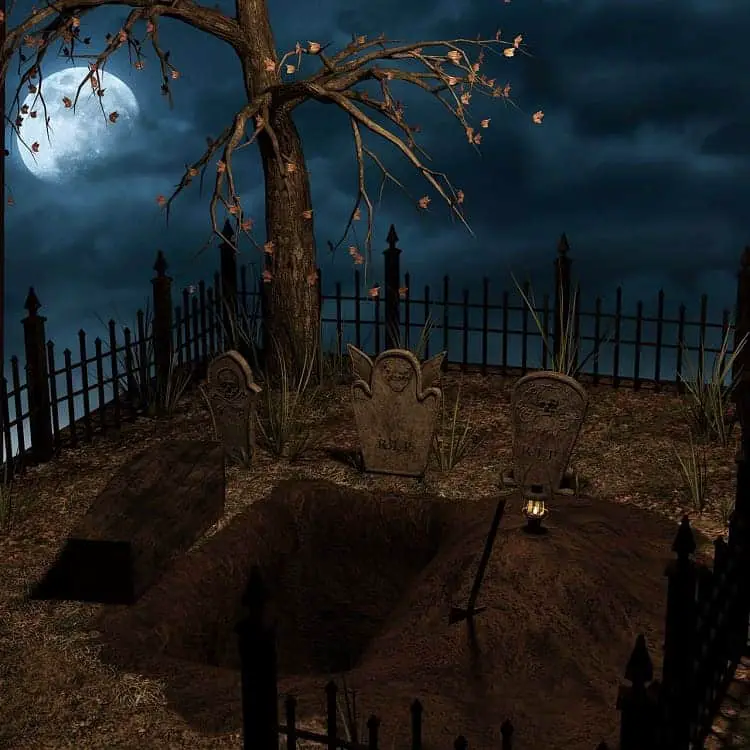
Speculation on how the body snatchers worked circulated amongst the press for some time with a few commentators, in the beginning, thinking that the whole coffin was removed from the grave in order for the cadaver to be snatched.
This was certainly not the case. Time was of the essence in every raid, and there was no way that a coffin could be exhumed quickly enough.
Instead, body snatchers would target the head end of the coffin, digging down with their wooden shovels, until they heard the thud of the coffin lid. They would pile the soil that they’d removed onto the lower end of the coffin so that by the time they reached the lid, it would act as a cantilever. A crowbar could then be inserted under the top, lifted up, and the lid snapped straight across the chest area.
Hooks would then be placed under the cadavers armpits and the tugging would commence.
Following rule No. 3, the grave would then have been refilled and the surrounding grass cleared of any debris. The graveyard left so that it could be targeted again, no doubt in a few days’ time.
If the process was done correctly, a cadaver could be snatched in less than one hour.
Researching ‘The Key 5’
You have to dig deep to find the hidden rules that body snatchers would have followed, but they are there to be found once you know where to start looking.
Newspapers
If you subscribe to The British Newspaper Archive you will have access to thousands of historic newspapers and within their pages, you can find a wealth of information relating to body snatching. You can try searching for specific cases or just search through the pages of a favourite publication. You never know what you might find.
The ‘Diary’
The ‘Diary’ was believed to have been written by Joseph Naples between the years 1811-1812 and covers only 16 pages in total. It is a vital source of information for any body snatching historian, giving a detailed account as to the dealings of the Borough Gang who operated throughout London during this period.
You can get a fragmented printed version of the Diary from AbeBooks.co.uk
There are some great books on the subject of body snatching and I dive into many different volumes when I carry out my research, including using my own as a reference book.
Other books that are good for all-round information on body snatching include the classic work by Ruth Richardson ‘Death, Dissection and the Destitute’ which is used by countless fans on the subject and also Norman Adams ‘Dead and Buried?’ again, a book that is becoming a bit of a legend in the world of body snatching.

